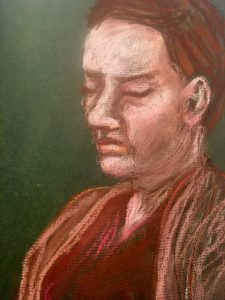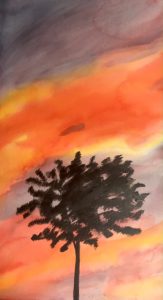As a reporter in Northwest Arkansas, I get a front-row seat to history… but also I just go to a lot of meetings.
These gatherings give me a great opportunity to sketch out what I am seeing. I make sketches of county and city department heads, government leaders and people attending meetings. I make a sketch of someone — even other reporters — at least once a day.

Making a series of quick sketches helps me concentrate on what my sources are saying, but it also helps me improve my drawing and basic art skills.
Sketches can be more difficult than fully formed paintings. They require a massive amount of quick observation — something reporters strive for, too.
To the left, I sketched a department head as she waited in the Washington County Quorum Courtroom in Fayetteville, Arkansas. The sketch is done in pastels and layered with soft pinks.
I was looking for color and tonal consistency in piece, so I repeated the colors often. Notice the color in her hair is also in her lips and downcast eyes. You can also see that the green I used as my base sketch is evident in her hair.
In this portrait sketch, I attempted to capture the dramatic lighting from direct overhead lighting in the courtroom. The effect came out similar to chiaroscuro, where there is a strong contrast between the illuminated and the shaded areas.
To the left, below “Juliet,” is a sketch of another Quorum Court attendee, Lanie Miller. This sketch is a little different because it includes ink.

Again, this subject interested me because of high contrast. Her blond hair and skin became extremely highlighted by the florescent lights overhead.
Miller is a regular attendee at county government meetings, and she has interesting features I don’t often see. That includes a very lovely sloped forehead. I tried to capture both the dramatic light and interesting features in her physical form and body language.
Other times when I sketch, I use only ink on Reporter’s Notebook.
Below are two examples of this technique, where I am learning the features and trying to capture the movement. None of my subjects are still for very long because they rarely know I am sketching them. These sketches must be fast, up to 5 minutes tops.

To the right, the county fire marshal attends planning meetings to talk about visiting sites that plan to develop and talking about safety needs.
In this rendering, I drew Ledbetter in ink over the top of my notes. To me, this is a sign of a true sketch. The work is very lose and starts by defining the planes of the face.
Two other examples (below) are from my time covering Tontitown, Arkansas.

I sketched Alderman Art Penzo on “Reporter Notebook” paper and then cut the image out of my notes. I then simply took a blue highlighter from my bag and used it to darken the shadows I had sketched out.
If you look closely, you can see that I had started sketching a different alderman and then switched when Art began became still during the meeting.
Art has an interesting way about him and that is what drew me to sketch him. He is intense but thoughtful, and I believe this comes out in the sketch.

To the left, I used hatching to create a dramatic contrast on Joe Edgmon, who was a Tontitown alderman in 2015. Joe also has an interesting profile that is different from most of the people with Italian heritage living in Tontitown.
This sketch is also done on Reporter Notebook paper.

To the left is one of my favorite quick sketches. This one actually is longer than 5 minutes, so I had time to concentrate on the expression and deep shadows.
Lehman, 78, is done in purple marker on pastel paper, 5 by 7 inches. He is probably one of the most interesting people I’ve met, and I attempted to capture that nostalgic gaze that crosses his face often.
The key to good sketches is to just continue to sketch. I have hundreds of failed sketches. But, I can’t resist the next challenge. I look at the planes of the face, find out why I am drawn to the subject and then just… sketch.







